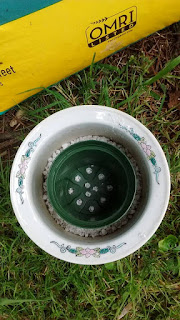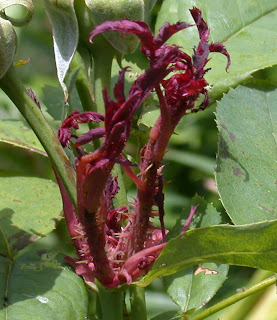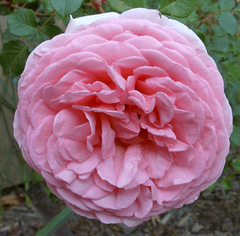A Venus Flytrap Looking Perky and Happy in his New Insulated Pot (above)
Earlier this year, I purchased a Venus Flytrap on a whim (Aldi's of all places had them for a song) and promptly killed it. It was suggested to me that I should have placed it in a closed terrarium. I've been playing with succulents in terrariums and happened to have an unused egg-shaped one with a lid. I stopped at my local Lowe's Hardware and picked up another to try again. Having done some research, I found sites that described how to place one in such a terrarium, but I also came across discussion boards and other sites where keepers of carnivorous plants explained why this was a bad, bad idea.
A Terrible, No-Good Idea
You see, while Venus Flytraps do like a good amount of moisture and humidity, they are more like citrus, in that they want that abundant moisture, but they also want the water to flow through their root zone, rather than stagnate. They are not going to do well in standing moisture, with limited air flow as a terrarium (either open-style or with a lid) provides. While they can take a little time in standing water, thrive even for a bit, prolonged periods will bring on fungal issues and eventually kill them. Of course, they can thrive in an outdoor bog setting if your temperature zone allows (zone 8 and above). Mine is not quite there (7b) so I'm opting for an indoor set-up.
They also need to be potted up alone, as they have a dormancy period that is a bit different than other carnivorous plants. During this time, while they should still never be allowed to dry out completely, their water supply should be reduced. There's more to know about their dormancy period, but we'll save that for another time, as right now, we're just trying to keep the plant from dying in his little Box of Doom that the big box stores usually have them potted up in.
The Captain sits inside his Box of Doom beside his Unassembled New Home
I amuse myself by giving my plants, garden areas, and whatever else strikes my fancy, rather ridiculous names so this is Captain Von Trapp (oh yeah, I'm going for the obvious cheesiness of it there, ha!). The Captain's packaging is too much like that undesired terrarium, so this situation will not abide. I'm going to set up a DIY insulated pot for the Captain using a pretty glazed pot as the exterior with a smaller plastic pot set up within it.
Creating an insulated pot will help buffer the root system from feeling big swings in temperature. Plants set in the ground get natural buffering from the earth they sit in. An insulated pot mimics this, providing more protection for sensitive plants like the Captain, than a pot without insulation. There are insulated pots for purchase at many garden and big box stores. Some DIYers make pots out of cute, ready-made insulated containers - like mugs - by drilling or puncturing the bottoms to make drainage holes. I'm going to use two pots I already had sitting around, and the perlite that I'll also use for the soil mix, to create my own insulated pot.
Also of consideration is the type of pots chosen. Plastic, glass, or high-fired glazed pots are good choices. Here, the aim is to avoid any pots that might leech minerals or impurities into the Captain's sensitive root zone. With this in mind, my pots are also nice and clean.
First step is to cover the bottom of the larger pot with a layer of perlite. Be sure to use perlite that has no additives. Place the smaller pot on top of that layer and check to see that the tops of both pots are even. If not, add or remove perlite as needed to level them.
Assembly of the Insulated Pot
First step is to cover the bottom of the larger pot with a layer of perlite. Be sure to use perlite that has no additives. Place the smaller pot on top of that layer and check to see that the tops of both pots are even. If not, add or remove perlite as needed to level them.
Scoop more perlite between the two pots, filling in the area completely. If a few stray bits fall into the inner pot, there is no need to worry. You can pick bits out if you think an excessive amount has fallen in. There are a few bits in there, seen in my photo below. This is not an amount I'm going to bother with, so there they will stay as I begin the last steps before settling the Captain in.
Now it's time to put together the soil mix. Once again, the sensitive roots are what I am catering to. A basic mix of equal parts peat moss (decayed sphagnum moss) and perlite will supply nice drainage but allow enough moisture retention that the Captain should live much longer than his predecessor (RIP Trapper John). It is important to choose peat moss and perlite that do not have any added ingredients like fertilizers. I was able to find both of these at the Home Depot near my house, but had to buy much larger bags than this project requires. The only smaller bags available had additives that the Captain would not tolerate. Luckily, I have other uses for these and both are inexpensive.
Now it's time to put together the soil mix. Once again, the sensitive roots are what I am catering to. A basic mix of equal parts peat moss (decayed sphagnum moss) and perlite will supply nice drainage but allow enough moisture retention that the Captain should live much longer than his predecessor (RIP Trapper John). It is important to choose peat moss and perlite that do not have any added ingredients like fertilizers. I was able to find both of these at the Home Depot near my house, but had to buy much larger bags than this project requires. The only smaller bags available had additives that the Captain would not tolerate. Luckily, I have other uses for these and both are inexpensive.
Making the Soil Mix
To measure equal parts (by volume, not weight) of my peat and perlite, I used a little red bowl to scoop from each. This will make more soil that I need, but the remainder will store easily for another use.
An old Tupperware container from a thrift store makes for handy mixing and storage. I don't worry about being too exact - I'm not baking a cake here - just scoop them together
Hand mixing such a low volume is easy peasy. Just plunge your hands in and stir them about. I always wear gloves when I make soil mixes. I'm not really sure that it is necessary with this simple mix. When it looks well combined, it is ready for use.
Bustin' out the Captain
I have left the Captain stewing in his Box of Doom until everything is ready for his arrival. He is a good healthy looking specimen, with a cute little rosette of traps.
Inside the plastic box there is another plastic piece that holds the Captain's pot in place. I pull that piece and the potted plant out all at once and then remove the Captain from his pot and out into my hand. In the picture some of the sphagnum moss (it is the not-decayed type that is light colored and stringy looking) that was wrapped around his little root can be seen. This type of moss is often used like this around the roots of flytraps. The one I killed, I had left in this type of planting. I believe this to have been one of my mistakes. The decayed version of sphagnum (which is dark and dirt-like) mixed with the perlite, should allow much better drainage while still offering the Captain some moisture retention.
After gently lifting the last of the moss from around the roots, the Captain is held in his pot and the soil mix gently scooped in around and covering the roots. When the pot is filled in, lightly pat the soil into place. The moss removed from the plant can be used as decorative cover over the perlite (as shown below).
Using the red bowl again, I brought some water from the rain barrel and let it trickle into the Captain's new pot. Like other carnivorous plants, Captain Von Trapp likes pure rain water or distilled water. Tap water has minerals along with other additives that will harm sensitive plants like the Captain. To get around this you would need a reverse-osmosis water treatment system, which isn't as expensive as it used to be. Still, I have a mortgage to pay so for now, I stick to the rain barrel water or jugs of purchased distilled water for my carnivorous plants and shrimp tank.
The goal now that he is settled in, is to keep the Captain moist, but not water-logged. With the original potting materials removed and the new soil mix and insulated pot in place this should be easier to maintain. So far so good. Cross your fingers for me and the Captain.































































